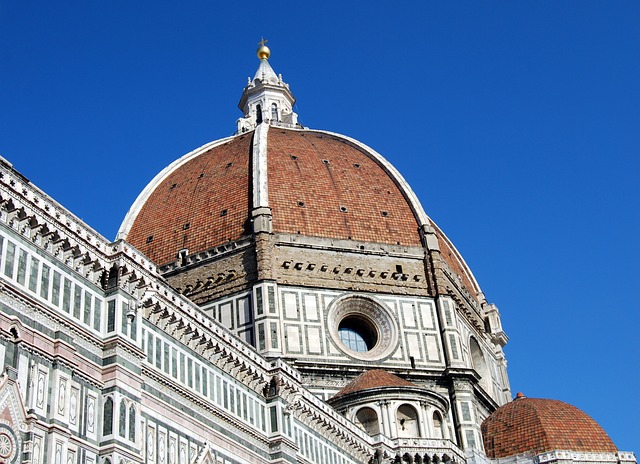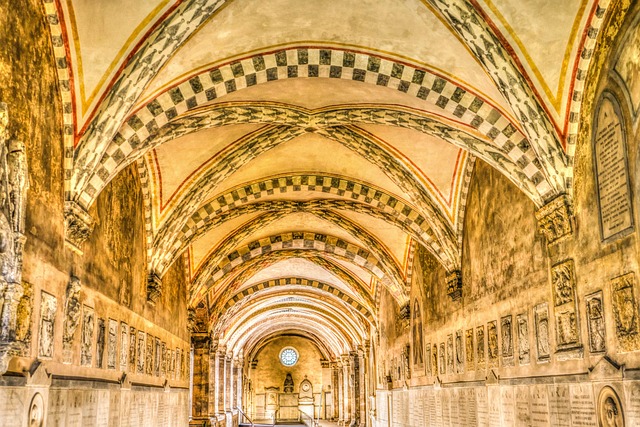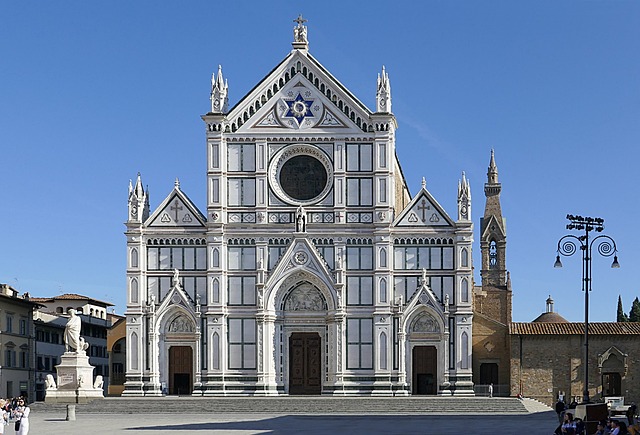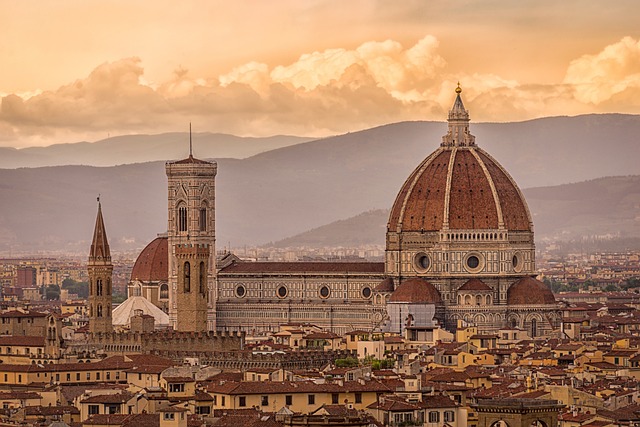7 Unmissable Churches in Florence
Exploring Florence means immersing yourself in a unique cultural heritage, and its churches represent some of the city’s most fascinating wonders.
This article will guide you through the 7 must-see churches, highlighting the art, architecture and history of each place.
We will invite you to discover religious treasures that reflect the grandeur of the Renaissance and will leave you breathless.
Prepare your itinerary and get ready for an unforgettable experience in the heart of Florence! 
The Duomo of Florence
When you visit Florence, you absolutely cannot miss the magnificent Cathedral of Santa Maria del Fiore, considered one of the city’s most iconic symbols.
Its extraordinary architecture and majestic dome designed by Filippo Brunelleschi not only dominate the Florentine skyline, but also tell a compelling story that dates back to the 13th century.
Begun by Arnolfo di Cambio, the cathedral’s construction took centuries to complete, including a celebration of the divine Renaissance art that made it world famous.
The finely decorated white, pink and green marble facade is a masterpiece of Gothic style that will leave you breathless.
History and Architecture
The history of the Duomo is fascinating and full of significant events.
Completed in 1436, the Duomo has seen centuries of works of art and faith pass by, becoming not only a place of worship but also a symbol of Florentine power and culture.
The dome, which is still the largest masonry dome in the world, is an ingenious example of engineering and architecture from the Renaissance period.
Its bold design has inspired architects and artists around the globe, and by climbing its 463 steps, you will have the opportunity to appreciate not only the architectural details, but also an unforgettable panoramic view of the city.
Elements Not to Be Missed
During your visit to the Duomo, there are some must-see elements that will enrich your experience.
Don’t miss the opportunity to admire the frescoes of the Last Judgment, beautifully painted by Giorgio Vasari inside the dome.
In addition, be on the lookout for three extraordinary 15th-century frescoes in the nave by the likes of Domenico da Michelino.
These masterpieces not only beautify the interior of the Duomo, but will also allow you to immerse yourself in the spiritual and historical depth of this sacred place.
Also, visit the Baptistery of San Giovanni next to the Duomo, famous for its bronze doors, and Giotto’s Bell Tower, from which you can enjoy another breathtaking view of the city.
Every corner of the Duomo tells a story; take your time to explore it and appreciate its magnificence.
Don’t forget to take some photos, because the memories of this experience are a treasure you will carry with you forever.
The Church of Santa Maria Novella 
The Church of Santa Maria Novella is one of Florence’s architectural gems and a must-see for anyone visiting the city.
Located in the heart of the Tuscan capital, this church is a perfect example of Gothic architecture integrated with Renaissance elements.
At a glance, the facade, skillfully designed by Leon Battista Alberti, looks like a work of art in its own right, adorned with white and green marble that harmoniously complement each other, capturing the light in fascinating ways.
As soon as you enter, you are greeted by the serene and contemplative atmosphere, where the play of light and shadow creates a unique visual experience.
Desideri maggiori informazioni su questa location?
Contattaci adesso su Whatsapp cliccando sull'immagine qua sotto, avrai un consulente dedicato che in tempo reale risponderà alle tue richieste e ti consiglierà la soluzione migliore per la tua vacanza.

Facade and Interior
The façade of the church, completed in the 15th century, is a perfect fusion of elegance and simplicity, featuring a large central rose and several niches housing important sculptures.
However, what will surprise you most is the interior, where you will find soaring columns and pointed arches leading your eyes to the imposing ceiling.
The interiors, with their frescoes and artwork, offer a visual experience that tells the religious and cultural history of the city, making it a meaningful place for visitors.
Artistic Works
Santa Maria Novella is not only a place of worship, but also a museum that houses some of the most important masterpieces of Renaissance art.
Inside, you can admire works by great masters such as Giotto’s Crucifix, considered one of his most significant works, and Ghirlandaio’s frescoes, which tell biblical stories through a powerful and innovative visual language.
In addition, Masaccio’s famous “Trinity” represents a landmark in art history, being an early example of linear perspective applied to sacred art.
Don’t forget to take the time to observe every detail of the artistic works.
For example, Giotto’s Crucifix is appreciated not only for its artistic beauty but also for the emotion and spirituality it conveys, bringing you closer to the message of faith in a deep and personal way.
In this way, the church becomes not just a tourist visit, but an enriching experience that you will take with you even after you leave Florence.

The Church of the Holy Cross
The Church of Santa Croce is one of the most important cultural destinations in Florence and is a veritable mausoleum for some of the most illustrious personalities in Italian history.
When you cross its threshold, you find yourself in a place rich in history, where every nook and cranny tells of the lives of artists, scientists and men of letters who shaped the country’s destiny.
The grandiose facade, initially unfinished until the 19th century, is an expression of the Florentine Gothic style, while the interior holds artistic wonders that capture the attention of every visitor.
Distinguished Burials
One of the most fascinating aspects of the Church of Santa Croce are the tombs of some of Florence’s most illustrious citizens.
Walking among the tombs, you can read names such as those of Michelangelo, Galileo Galilei, and Niccolò Machiavelli, each of whom contributed significantly to world culture and history.
These burials are not only a tribute to their memory, but also an opportunity to reflect on their extraordinary lives and accomplishments.
Art and History
Inside the church, art blends with history, creating a unique atmosphere that you cannot miss.
Giotto’s frescoes and the works of other great masters such as Donatello enrich the artistic heritage of the place, making it an indispensable landmark for Renaissance art lovers.
The Bardi Chapel and Peruzzi Chapel, decorated with frescoes by Giotto, transport you to the time when Florence was the beating heart of European culture.
The Church of Santa Croce, with its rich history and important works of art, provides an unmissable opportunity to understand the deep connection between faith, art and culture that characterizes Florence.
Each visit is not only a journey into the past, but also an opportunity to admire some of the most significant masterpieces in art history, all set in one of the city’s most iconic spaces.
The Church of Orsanmichele
The Church of Orsanmichele is a place that holds millennia of history and art in the heart of Florence.
Originally built as an oratory dedicated to St. Michael the Archangel, its strategic location in the center of the city made it an important stop for merchants and inhabitants.
Today, it represents not only a sacred building but also a symbol of Florence’s civic and commercial life.
Distinguished by its ornate facades and imposing tabernacle, its architecture is a masterpiece that leaves anyone who visits it speechless.
Origins and Function
The origins of the Church of Orsanmichele date back to the 14th century, when the site was occupied by a grain market known as the “Loggia del Grano.”
This oratory, however, began as a simple place of worship for market workers, but soon became a very important center of devotion for the Florentine community.
Its transformation into a church took place over time, making Orsanmichele an important witness to Florence’s civic devotion.
Works by Famous Artists
Inside the Church of Orsanmichele, you can admire works of art created by some of the greatest artists of the Renaissance, such as Donatello and Ghiberti.
The tabernacles on the façade, dedicated to the patron saints of the Florentine guilds, are richly adorned with sculptures that tell sacred stories and reflect the mastery of their creators.
Every detail is designed to inspire awe and veneration in visitors, highlighting the importance of religion and art in Florentine life.
Particularly iconic is Donatello’s statue of St. George, a masterpiece that recounts not only the figure of the patron saint of the frescanti, but also the artistic grandeur of the time.
In addition to the statues, the frescoes inside and the various decorations make it an extraordinary example of how religion and art were intertwined in Florence’s history.
By visiting the Church of Orsanmichele, you will have the opportunity to immerse yourself in an era of extraordinary creativity and spirituality, while being inspired by the works that adorn this magnificent place of worship.
The Church of the Holy Spirit
If you are in the Oltrarno district, a visit to the Church of Santo Spirito is a must-see.
This church, despite its simple and sober appearance, holds within it an artistic richness and a fascinating history.
The building, designed by Filippo Brunelleschi, reflects the essential and harmonious lines typical of the Renaissance, but the interior has a Baroque feel that creates a striking contrast, making it a unique example of stylistic fusion.
As you approach, you cannot help but notice how the unassuming exterior hides a real treasure inside.
Architectural Style
The Church of Santo Spirito presents an architectural layout that follows Renaissance principles, favoring symmetry and balanced proportions.
You can admire the simple facade, devoid of excessive decoration, reflecting the humanist ideal of beauty through sobriety.
As you enter the church, you will be confronted with a wide nave equipped with six side chapels, all featuring a sense of space and light that encourages contemplation and spirituality.
Artistic-Cultural Attractions
Inside the Church of Santo Spirito, there are valuable works of art, including the famous Nerli Altarpiece by Filippino Lippi and a wooden Crucifix carved by Michelangelo.
These works not only enrich the church’s artistic heritage, but also offer insights into the life and thought of the Renaissance.
The combination of architectural elements and works of art allows you to immerse yourself in Florentine culture and understand the city’s artistic roots.
In addition, the square in front of the Santo Spirito Church is a bustling center of activity, where you can immerse yourself in local Florentine life.
Street performers, merchants, and small cafes create a charming atmosphere that makes each of your visits a special moment.
Don’t forget to take time to explore the surroundings and appreciate this authentic part of Florence.
The Church of San Miniato al Monte
The Church of San Miniato al Monte is undoubtedly one of the architectural jewels of Florence, situated in a privileged position on the hill overlooking the city .
This cathedral, built in the Italian Romanesque style, is known for its magnificence and artistic details.
The entrance is adorned with a splendid staircase, while inside you will find a magnificent gold-backed mosaic depicting Christ Enthroned, a precious work that testifies to the grandeur of medieval faith and art.
The church, completed in the 13th century, also hides a fascinating cycle of frescoes and a crypt frescoed by Taddeo Gaddi, making it a must-see for art and history enthusiasts.
Location and Mosaic
Positioned on the Piazzale Michelangelo, the Church of San Miniato al Monte offers easy access, but it is also one of Florence’s most impressive vantage points.
From here, you can enjoy breathtaking views encompassing the city’s historic center, its iconic monuments and the surrounding rolling hills.
The golden mosaic, visible at the entrance of the church, is not only a work of art, but also a symbol of hope and sacredness that welcomes visitors, inviting them to explore the beauty within.
Panoramic View
The panoramic view from the Church of San Miniato al Monte is an experience not to be missed.
From its elevated position, you can observe the wonderful architecture of the Cathedral of Santa Maria del Fiore and the majestic Ponte Vecchio, not to mention the hills that frame the panorama.
Every moment of the day offers a different scenery: at sunset, the sky is tinged with warm hues that make the panorama even more striking.
This is the ideal place for a contemplative break, where you can breathe in the fresh air and enjoy a quiet moment away from the hustle and bustle of the city.
In addition, the Church of San Miniato al Monte is the perfect place to take memorable photographs, creating lasting memories of your visit to Florence.
The combination of art, history and the splendid view makes every moment spent here a unique experience that will enrich your stay in the cradle of the Renaissance.
The Church of San Lorenzo
History and Significance
The Church of San Lorenzo is considered one of the oldest churches in Florence, with origins dating back to the 4th century.
Built by the Medici family, the church has always played a crucial role in the city’s religious and cultural life.
Despite its rich history, the facade remains unfinished, a detail that makes it all the more fascinating.
Its three naves are an extraordinary example of Renaissance architecture, conceived by great artists of the past, including the famous Brunelleschi, who also designed the interior chapels.
Inside, you will find magnificent works of art that reflect the glory of the Medici family and its influence on Florentine society.
Importantly, San Lorenzo also houses the Medici Chapels, a must-see for visitors who want to delve deeper into the Medici dynasty’s history and artistic legacy.
A visit to this church is not just an exploration of its structure, but also an immersion into the rich tapestry of Florentine history.
Works of Michelangelo
Inside the Church of San Lorenzo, Michelangelo’s works are a highlight of your tour.
Among the most famous are the sculptures that adorn the New Sacristy, an architectural masterpiece created by Michelangelo himself to house the tombs of the Medici family.
Here, you can admire the contrast between the sculptural power of the figures and the serenity of the sacred place.
The presence of Michelangelo’s works in San Lorenzo not only enriches the church’s artistic heritage, but also offers a testimony to the connection between art and spirituality that characterizes the Renaissance.
The famous statues, such as the “Double” and “The Last Judgment,” reflect the artist’s mastery and emotional depth, making this church a place of great inspiration for every visitor. 
The 7 Unmissable Churches of Florence: A Guide to Religious Wonders to Visit
As you navigate the streets of Florence, you will come across one of the most extraordinary concentrations of religious beauty in the world.
The churches you’ve just explored bear witness to the city’s artistic and cultural richness, each with its own unique history and spellbinding works of art.
From the majestic Cathedral of Santa Maria del Fiore, the undisputed symbol of Florence, to more hidden places like the Church of Santo Spirito, each visit is an opportunity to deepen your knowledge of the Renaissance and the figures who marked it.
Take time to discover these treasures; each church offers a unique experience and a new perspective on the extraordinary beauty of Florence.
Remember that your visit is not just limited to contemplating the works of art, but also extends to reflecting on the spirituality and history that permeate these walls.
Be sure to include these seven churches in your itinerary, as they are an essential part of your Florentine adventure.